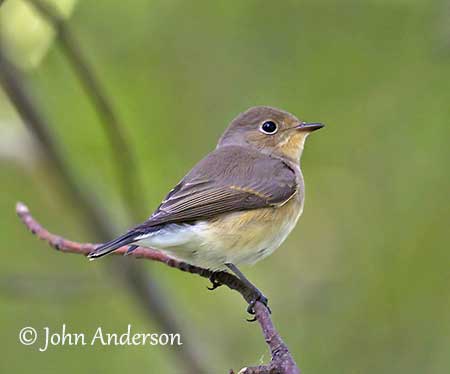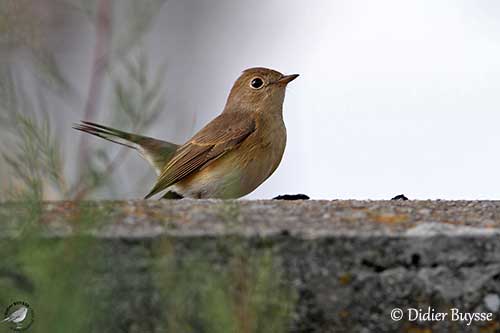
Fr: Gobemouche nain
Ang: Red-breasted Flycatcher
All: Zwergschnäpper
Esp: Papamoscas gris
Ita: Pigliamosche pettirosso
Nd: Kleine Vliegenvanger
Sd: mindre flugsnappare
Photographers:
John Anderson
John Anderson Photo Galleries
Didier Buysse
Vision d’Oiseaux
Jean-Claude Jamoulle
A la rencontre des Oiseaux
Text by Nicole Bouglouan
Sources:
HANDBOOK OF THE BIRDS OF THE WORLD Vol 11 by Josep del Hoyo, Andrew Elliott and David Christie - Lynx Edicions - ISBN: 849655306X
THE HANDBOOK OF BIRD IDENTIFICATION FOR EUROPE AND THE WESTERN PALEARCTIC by Mark Beaman, Steve Madge - C.Helm - ISBN: 0713639601
ENCYCLOPEDIE DES OISEAUX DE FRANCE ET D’EUROPE – de Peter Hayman et Rob Hume - Flammarion – ISBN : 2082009920
BIRDS OF THE MIDDLE EAST by R.F. Porter, S. Christensen, P Schiermacker-Ansen C.Helm - ISBN: 0713670169
What Bird-The ultimate Bird Guide (Mitchell Waite)
Wikipedia, the free encyclopaedia
BioOne - Natural Nest Sites of the Red-Breasted Flycatcher Ficedula parva in a Primeval Forest
Red-breasted Flycatcher
Ficedula parva
Passeriformes Order – Muscicapidae Family
INTRODUCTION:
The Red-breasted Flycatcher is now a monotypic species since the Taiga Flycatcher (F. albicilla) is considered a full species. However, their ranges overlap in W Siberia.
The flycatchers of genus Ficedula are small, with small body, rounded head and short bill. They breed in forest and woodland. The male shows brighter plumage than the female, and in the present species, the red throat is conspicuous during the displays.
The Red-breasted Flycatcher is a W Palearctic species that spends the winter in Pakistan and India. This species is threatened by deforestation involving the loss of nesting sites. But it is currently not globally threatened.

DESCRIPTION OF THE BIRD:
Biometrics:
Length: 11,5 cm
Wingspan: 19-21 cm
Weight: 11-12 g
The Red-breasted Flycatcher adult male in breeding plumage (not displayed) has brown upperparts and upperwing. Flight feathers and upperwing-coverts have narrow, pale brown edges. The uppertail-coverts are darker, mostly blackish-brown with grey-brown tips. The tail is blackish-brown with white bases to outer rectrices.
On the underparts, chin, throat and breast are orange-red (often brighter in older males) bordered with grey on sides of upper breast. Rest of underparts is white with creamy-buff wash on flanks and sides of lower breast. The thighs are brownish. On the underwing, axillaries and coverts are creamy-buff.
The two-tone bill has blackish upper mandible and yellowish to flesh pink lower mandible, sometimes darker at tip. The eyes are dark brown. Legs and feet are dark brown.
In non-breeding plumage, it has less extensive orange-red on chin and throat, but the flanks are more buffish.
The Red-breasted Flycatcher adult female has mostly brown (with no grey tinge) foreneck, hindneck and crown. The lores are buffy-white whereas the ear-coverts are pale brown. We can see a narrow, creamy-white eyering. Upperparts and upperwing are as male, and she has blackish uppertail-coverts.
On the underparts, she has creamy buff chin, throat, breast sides and flanks, and white rest of underparts.
The juvenile has spotted appearance with rufous brown lores, ear-coverts and upperparts, with narrow, darker feather edges. The underparts are buff, yellower on breast and flanks. Belly and undertail-coverts are white.
The first winter resembles female but it has a narrow, rufous-buff wingbar formed by the paler tips and edges of some wing coverts.
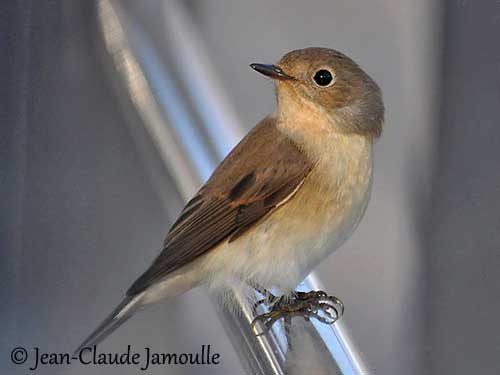
RANGE:
The Red-breasted Flycatcher breeds in C, E and SE Europe (from C Finland, SE Sweden, Denmark, N Germany, Austria, Croatia and N Greece), E to SW Siberia, N Turkey, Caucasus and N Iran. It winters in Pakistan and N, W and C India. It is scarce in N Africa.
HABITAT:
The Red-breasted Flycatcher breeds in both mixed and deciduous woodlands near water, and usually favours mature forests with clearings and watersides. It may frequent orchards too, and locally spruce forests. It often breeds at high altitude, between 800 and 3,000 metres.
On passage, it can be seen in scrub and anywhere with trees. During winter, it frequents woodlands with grassy undergrowth, and drier oak forests.
CALLS AND SONGS: SOUNDS BY XENO-CANTO
The Red-breasted Flycatcher gives a dry, rolling “terrrr” almost wren-like but weaker. It also utters a thin “tsri”, a plaintive “weeit”, and the alarm call is “tee-lu”.
The song is a series of sweet notes descending in tone towards the end “tle-tle-tle, tlee-lu, tlee-lu, tlee-lu, tiu-tiu-tiu-vit-vit” fairly similar to Willow Warbler’s song.
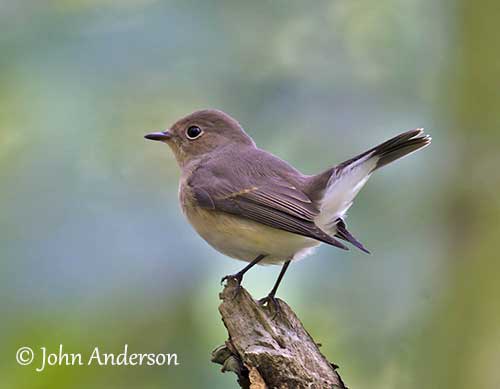
BEHAVIOUR IN THE WILD:
The Red-breasted Flycatcher feeds primarily on insects of several species, and also takes worms, snails and woodlice (Isopoda).
It feeds actively inside bushes and tree canopy, from low to middle level. It makes short sallies to catch insects in the air. It feeds by picking prey from the foliage, but also by flycatching, performing short flights within the canopy. It may come briefly to the ground to pick up an insect, but it returns quickly to the trees.
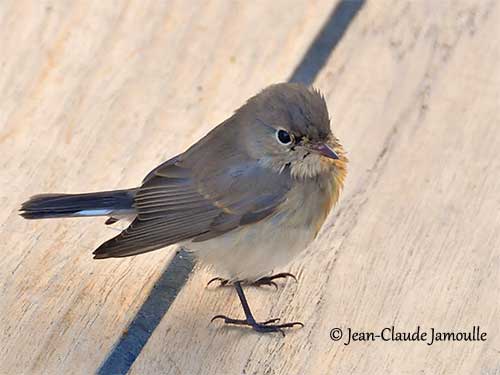
The Red-breasted Flycatcher is territorial during the breeding season. Like most Muscicapidae, it often flicks the wings and cocks the tail. This behaviour is used between mates as contact, and during aggressive displays.
This species is monogamous and solitary nester. The male is very active when attracting a female. When she approaches a singing male, it stops the song and utters short rattle calls while flicking both wings and tail. It also chases the female.
Later, the male flies to various nest-sites while singing loudly, entering each tree hole and making song flights. These displays end when the female follows the male into a hole. But if she leaves the hole first, the male has been rejected.
During the incubation period, the male accompanies and guards the female to protect her against other males. It also feeds her to maintain and strengthen the pair-bond.

The Red-breasted Flycatcher is a long-distance migrant. They move from September to December towards the wintering areas, but the departure from Europe starts in late July, and mainly August to mid-September.
The return passage starts mid-March with peak in April and continuing into May. They reach the breeding grounds between late April and early June.
The Red-breasted Flycatcher has weak, fluttering, direct flight with shallow wingbeats.
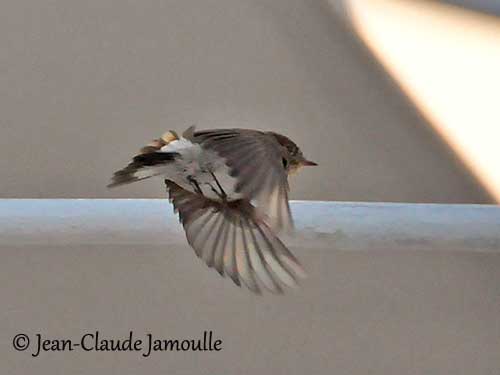
REPRODUCTION OF THIS SPECIES:
The breeding season occurs from mid-May to late June in C and E Europe, and late May and June in the eastern part of the breeding range.
The Red-breasted Flycatcher is monogamous. This species usually produces a single brood per season. It nests in hole in tree or wall, sometimes in nestbox. The female builds the nest, a cup made with moss, grasses and leaves, and lined with softer material such as plant fibers and hair. It is placed in a hole, usually 3-4 metres above the ground, sometimes higher.
The female lays 5-6 eggs at daily intervals. She incubates alone during 12-15 days, during which she is fed by the male. The chicks are fed by both parents and fledge 12-13 days after hatching. They still depend on adults for food during 8-10 days, and are independent at 27-29 days of age. The Red-breasted Flycatcher usually returns to the same nest-site year after year.
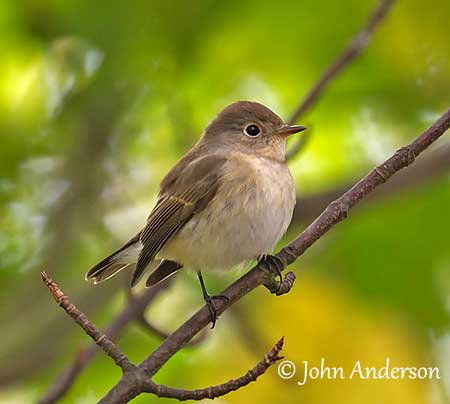
PROTECTION / THREATS / STATUS:
The Red-breasted Flycatcher is threatened by deforestation involving the loss of nesting sites. The European population remained fairly stable during 1970-1990, but due to contraction of the range, the numbers decreased in some regions while they increased in other areas.
The global population size is unknown, but the species is considered “common”.
The Red-breasted Flycatcher is currently evaluated as least Concern.
